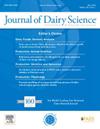Analysis of milk adulteration by means of a potentiometric electronic tongue
IF 3.7
1区 农林科学
Q1 AGRICULTURE, DAIRY & ANIMAL SCIENCE
引用次数: 0
Abstract
Milk adulteration presents substantial challenges in the food industry, prompting the need for efficient detection methods. This study introduces a potentiometric electronic tongue for rapid and accurate detection of milk adulteration. Using polymeric membranes with various integrated additives, the electronic tongue distinguished between different milk types and detected common adulterants. Experimental results demonstrated its effectiveness in discriminating raw, pasteurized, and medicated cow milk, as well as goat milk. Moreover, it successfully identified adulterants, such as water and cow milk, in goat milk samples. Chemometric analyses, including principal component analysis and partial least squares regression, correlated sensor responses with traditional milk parameters such as fat, protein, and lactose content with an R2 of up to 0.97 on the validation step. Strong correlations validated the electronic tongue's potential for rapid milk quality assessment. This innovative approach offers a cost-effective, reliable solution for detecting milk adulteration in contrast to current techniques that require numerous time-consuming experiments.
利用电位电子舌分析牛奶掺假。
牛奶掺假给食品行业带来了巨大挑战,因此需要高效的检测方法。本研究介绍了一种用于快速准确检测牛奶掺假的电位电子舌。电子舌利用集成了各种添加剂的聚合物膜,区分不同类型的牛奶并检测常见的掺假物质。实验结果表明,它能有效区分生牛奶、巴氏杀菌牛奶、药用牛奶以及山羊奶。此外,它还能成功识别羊奶样品中的水和牛乳等掺假物。化学计量分析(包括主成分分析和偏最小二乘法回归)将传感器响应与脂肪、蛋白质和乳糖含量等传统牛奶参数相关联,验证步骤的 R2 值高达 0.97。强烈的相关性验证了电子舌在快速牛奶质量评估方面的潜力。与目前需要大量耗时实验的技术相比,这种创新方法为检测牛奶掺假提供了一种经济、可靠的解决方案。
本文章由计算机程序翻译,如有差异,请以英文原文为准。
求助全文
约1分钟内获得全文
求助全文
来源期刊

Journal of Dairy Science
农林科学-奶制品与动物科学
CiteScore
7.90
自引率
17.10%
发文量
784
审稿时长
4.2 months
期刊介绍:
The official journal of the American Dairy Science Association®, Journal of Dairy Science® (JDS) is the leading peer-reviewed general dairy research journal in the world. JDS readers represent education, industry, and government agencies in more than 70 countries with interests in biochemistry, breeding, economics, engineering, environment, food science, genetics, microbiology, nutrition, pathology, physiology, processing, public health, quality assurance, and sanitation.
 求助内容:
求助内容: 应助结果提醒方式:
应助结果提醒方式:


